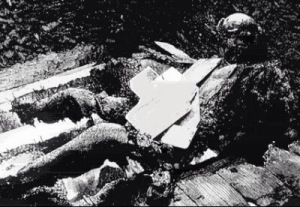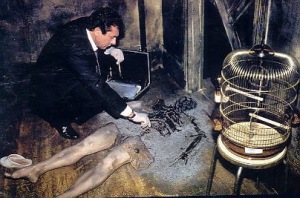
‘The Most Beautiful Suicide’, originally released on May 12, 1947 in LIFE Magazine
Sixty-nine years ago today, May 1st 1947, Evelyn McHale committed suicide by jumping from the 86th floor observation deck at the Empire State Building around 10:40 AM. The 23-year-old woman landed on a United Nations Assembly Cadillac Limousine that was parked on 34th Street approximately 200 feet (61 meters) west of 5th Avenue. Despite having fallen 1,050 feet (320 meters), her body appeared to be intact, even serene, as though she were sleeping. Her ankles are folded in a lady-like pose appropriate for the time, a gloved hand clutching her pearls, the only sign of damage is a tear in her hose. In contrast, the limousine her body rests on is crushed and broken glass surrounds the young woman. A patrolman named John Morrissey spotted a scarf drifting down from the Empire State Building which was shortly followed by Evelyn’s body. Her body landing atop the car created a cacophonic crash which alerted bystanders to the spectacle. Photography student Robert C. Wiles was across the street when he heard the loud, crunching of metal marking Ms.McHale’s suicide. In awe of her body’s unscathed appearance and leisurely posture, he snapped a photo approximately four minutes after her death. The photo was entitled “The Most Beautiful Suicide” and originally appeared on a full-page spread in the May 12, 1947 edition of Life Magazine with the caption, “At the bottom of the Empire State Building the body of Evelyn McHale reposes calmly in grotesque bier, her falling body punched into the top of a car.”. Unfortunately, not much is known about the life of Evelyn McHale, nor is there much known as to why she felt the need to take her own life.

Evelyn McHale
Evelyn was born on September 20, 1923 in Berkley, California to Vincent and Helen McHale. She was the 6th child born to a family of 7 children. When she was still very young, Evelyn’s mother, Helen, left the family for “material reasons” and her parents got a divorce. Her father retained full custody of the children and moved them to Washington, D.C. where he worked as a bank examiner. The family later moved to Tuckahoe, New York where Evelyn attended high school. After graduation, she joined the Women’s Army Corps and was stationed in Jefferson, Missouri. Eventually, she made her way back to New York State, living with her brother and sister-in-law in Baldwin, Long Island and got a job as a bookkeeper. Evelyn met Barry Rhodes, who was attending Lafayette College in Easton, Pennsylvania and had recently been discharged from the Air Force. They became engaged and were set to be married in June 1947 at Barry’s brother’s home in Troy, New Jersey. McHale had even been a bridesmaid in Barry Rhode’s younger brother’s wedding. On April 30, 1947 Evelyn took the train from New York to Easton, PA to visit Barry on his 24th birthday. On the morning of May 1, everything seemed normal, according to Barry Rhodes. He took his fiancé to the train station, kissed her good-bye, and at 7AM she boarded a train heading to Penn Station in New York City. Barry later told investigators, “When I kissed her goodbye, she was happy and as normal as any girl about to be married.”. Less than four hours later, Evelyn McHale was dead.

1947 article on the suicide of Evelyn McHale. Though her age is listed as ’20’ she was in fact, 23.
Detective Frank Murray discovered a few personal items belonging to Evelyn which were left behind on the observation deck: a tan (or gray, reports vary) cloth coat which was neatly folded and placed n the observation deck wall, a brown make-up kit filled with family photos, and a black pocketbook containing a suicide not. The note Evelyn McHale left, the only explanation of why she leapt to her death read, “I don’t want anyone in or out of my family to see any part of me. Could you destroy my body by cremation? I beg of you and my family- don’t have any service for me or remembrance for me. My fiancé asked me to marry him in June. I don’t think I would make a good wife for anybody. He is much better off without me. Tell my father, I have too many of my mother’s tendencies.”. Despite her near perfect appearance, according to reports, when her body was moved she “fell apart”, the impact having liquefied most of her organs. Ultimately, her body was identified by her sister, Helen Brenner. However, her final wishes were respected in that she was cremated, and there is no grave for Evelyn McHale. Whether she would be pleased by it or not, the entire world remembers Evelyn McHale, as she was immortalized for her serene suicide. Evelyn was the 12th person to ever jump from the Empire State Building since its completion in 1931. She was one of five people who jumped from the building in a three week period, an event which prompted the construction of a 10 foot tall (3 meters) wire mesh barrier, and the employment of guards trained to spot jumpers, in an effort to prevent any more suicides at the location.
If you enjoyed this article, please donate $1 to The Post-Mortem Post so we can make massive improvements to the site; If everyone who reads this article today donates just $1, we will surpass out goal.

‘The Most Beautiful Suicide’, colorized
Follow us on Twitter @PostMortem_post & Like The Post-Mortem Post on Facebook
If you enjoyed this article, you might also like Pray the Decay Away: Incorruptible Corpses and Other Forms of Natural Postmortem Preservation, Photographer Captures Couple’s Jump Into Yangtze River, Karl Wallenda’s Fatal Tightrope Fall, Possible Relatives: Tina Enghoff Photographs Homes of the Recently Deceased, Dying with Dignity: One Woman’s Willful Journey Into Death (VIDEO), The Bombing of Guernica and Germanwings Crash: Andreas Lubitz Suicide was a Mere Side Effect to the Murder of 149





